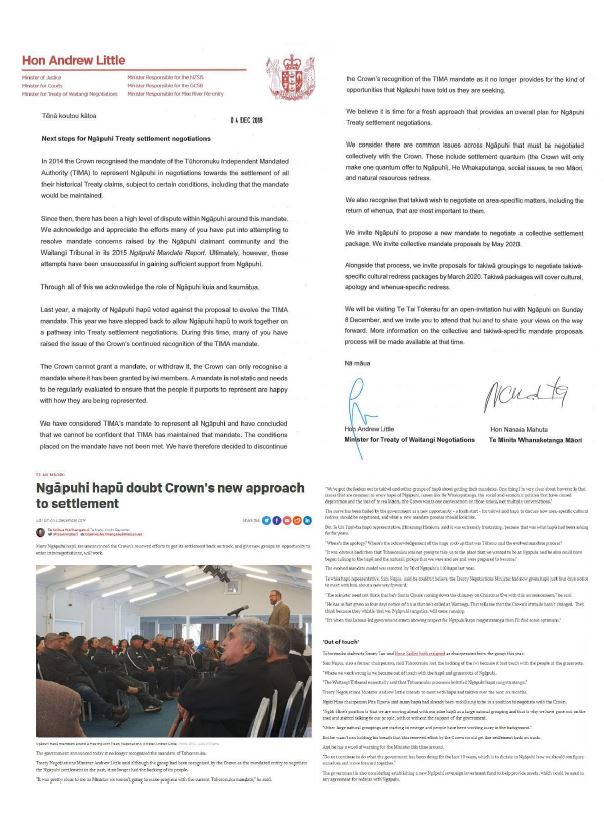
This letter calls out the Ardern Coalition Government for its fraudulent continuance of the Key and English ministries’ refusal to admit that Māori chiefs did not wittingly cede sovereign power in 1840. Steve Edwards’s letter to the Minister of Justice and Treaty Settlement Negotiations Minister, Andrew Little, and Māori Development Minister, Nanaia Mahuta – points out the Crown upholds of this ‘Treaty Cession Myth’. They fail to mention this myth in their letter seeking to re-engage Ngāpuhi in settlement negotiations. This omission means the Ardern Administration is in breach of section 240 of the Crimes Act, which deals with crimes of deceit.
Edwards sketches a stealthy two-track strategy comprising a ‘Colonial Law Track’ and a ‘Treaty Theatre Track’ – that was laid during the British takeover of New Zealand, to show that a series of legal moves to establish the colony were deployed, while the Treaty was hawked to construe a voluntary signing away of chiefly sovereignty. A wero is laid for the Crown to fess-up to this fiction at Waitangi 2020, concede more power to Māori, and suggests the British Monarchy sell its own feudal lands to pay for land buybacks – vested with Māori sovereign title.
6 December 2019
Tēnā kōrua Andrew Little and Nanaia Mahuta,*
Re: ‘Next Steps’ Letter to Ngāpuhi in Breach of Section 240 of Crimes Act for Lying by Omission
Your communiqué giving short notice of four days to hui with Ngāpuhi is in keeping with the Captain William Hobson’s weaponization of time to gain new territorial space for the British Masonic Empire.i
Because the letter of December 4 2019, entitled “Next Steps for Ngāpuhi Treaty settlement negotiations”, is written in your capacities as Crown Ministers, it is in breach of section 240 of the Crimes Act, which deals with crimes of deceit. The Crown continues to ignore the findings of the Waitangi Tribunal’s October 2014 report,ii that Ngāpuhi and other Treaty Chiefs did not cede sovereignty in 1840.iii
The Crown-sponsored “Next Steps for Ngāpuhi Treaty settlement negotiations”, is in breach of section 240 of the Crimes Act, because it, in essence, lies by omission.iv As an invitation to re-engage Ngāpuhi iwi, it fails to acknowledge the ‘Cession Myth’. Both of you well know that cession by treaty was a British Crown-scripted fiction. However, the machinations by the British to takeover New Zealand is worse that you think.
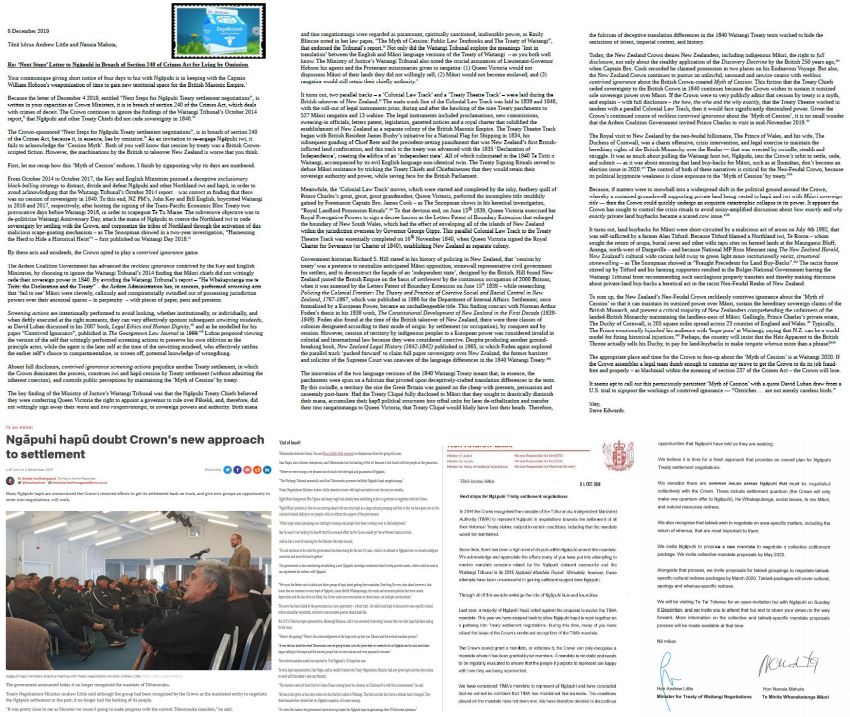
First, let me recap how this ‘Myth of Cession’ endures. I finish by signposting why its days are numbered.
From October 2014 to October 2017, the Key and English Ministries pursued a deceptive exclusionary black-balling strategy to distract, divide and defeat Ngāpuhi and other Northland iwi and hapū, in order to avoid acknowledging that the Waitangi Tribunal’s October 2014 report – was correct in finding that there was no cession of sovereignty in 1840. To this end, NZ PM’s, John Key and Bill English, boycotted Waitangi in 2016 and 2017, respectively, after hosting the signing of the Trans-Pacific Economic Bloc Treaty two provocative days before Waitangi 2016, in order to scapegoat Te Tii Marae. The subversive objective was to de-politicize Waitangi Anniversary Day, attack the mana of Ngāpuhi to coerce the Northland iwi to cede sovereignty by settling with the Crown, and corporatize the tribes of Northland through the activation of this malicious scape-goating mechanism – as The Snoopman showed in a two-year investigation, “Harnessing the Herd to Hide a Historical Heist”v – first published on Waitangi Day 2018.vi
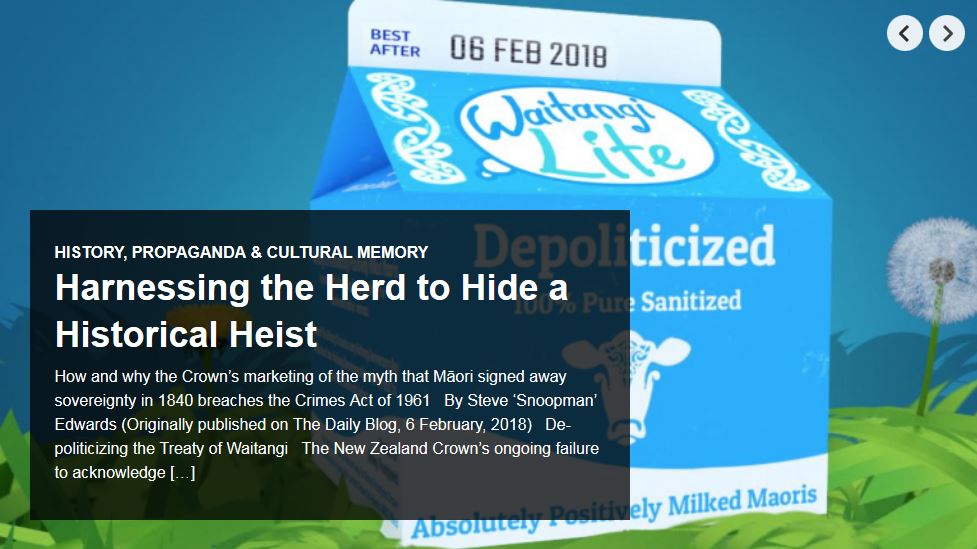
By these acts and misdeeds, the Crown opted to play a contrived ignorance game.
The Ardern Coalition Government has advanced the reckless ignorance contrived by the Key and English Ministries, by choosing to ignore the Waitangi Tribunal’s 2014 finding that Māori chiefs did not wittingly cede their sovereign power in 1840. By avoiding the Waitangi Tribunal’s report – “He Whakaputanga me te Tiriti: the Declaration and the Treaty” – the Ardern Administration has, in essence, performed screening acts that ‘fail to see’ Māori were cleverly, callously and conspiratorially swindled out of possessing jurisdiction powers over their ancestral spaces – in perpetuity – with pieces of paper, pens and presents.
Screening actions are intentionally performed to avoid looking, whether institutionally, or individually, and when deftly executed at the right moments, they can very effectively sponsor subsequent unwitting misdeeds, as David Luban discussed in his 2007 book, Legal Ethics and Human Dignity,vii and as he modelled for his paper “Contrived Ignorance”, published in The Georgetown Law Journal in 1999.viii Luban proposed viewing the version of the self that wittingly performed screening actions to preserve his own oblivion as the principle actor, while the agent is the later self at the time of the unwitting misdeed, who effectively ratifies the earlier self’s choice to compartmentalize, or screen off, potential knowledge of wrongdoing.
Absent full disclosure, contrived ignorance screening actions prejudice another Treaty settlement, in which the Crown dominates the process, construes iwi and hapū cession by Treaty settlement (without admitting the inherent coercion), and controls public perceptions by maintaining the ‘Myth of Cession’ by treaty.
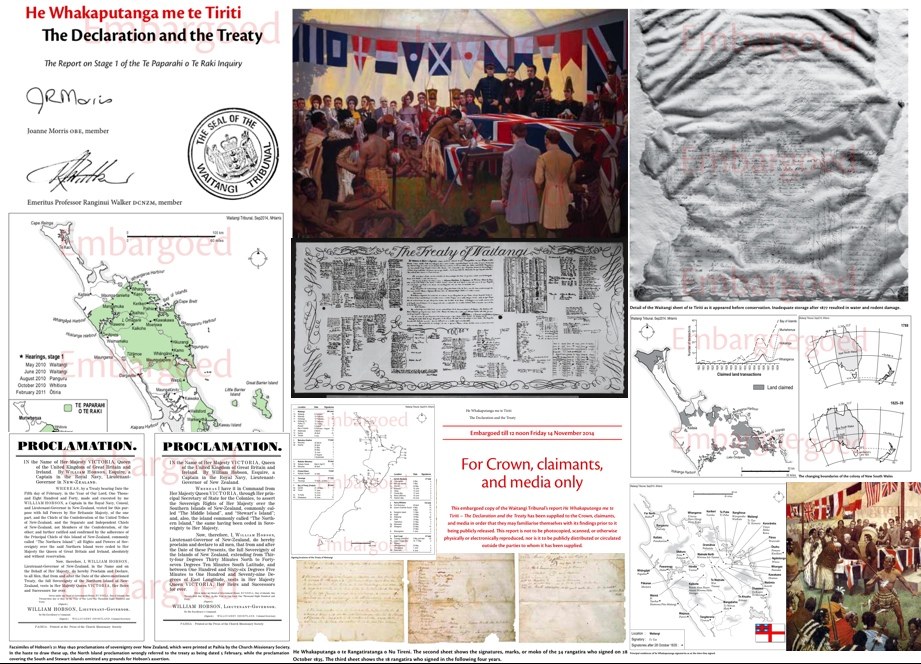
The key finding of the Ministry of Justice’s Waitangi Tribunal was that the Ngāpuhi Treaty Chiefs believed they were conferring Queen Victoria the right to appoint a governor to rule over Pākekā, and, therefore, did not wittingly sign away their mana and tino rangatiratanga, or sovereign powers and authority. Both mana and tino rangatiratanga were regarded as paramount, spiritually sanctioned, inalienable power, as Emily Blincoe noted in her law paper, “The Myth of Cession: Public Law Textbooks and The Treaty of Waitangi”, that endorsed the Tribunal’s report.ix Not only did the Waitangi Tribunal explore the meanings ‘lost in translation’ between the English and Māori language versions of the Treaty of Waitangi – as you both well know. The Ministry of Justice’s Waitangi Tribunal also noted the crucial assurances of Lieutenant-Governor Hobson, his agents and the Protestant missionaries – given to rangatira: (1) Queen Victoria would not dispossess Māori of their lands they did not willingly sell; (2) Māori would not become enslaved; and (3) rangatira would still retain their chiefly authority.x
It turns out, two parallel tracks – a ‘Colonial Law Track’ and a ‘Treaty Theatre Track’ – were laid during the British takeover of New Zealand.xi The main trunk line of the Colonial Law Track was laid in 1839 and 1840, with the roll-out of legal instruments prior, during and after the hawking of the nine Treaty parchments to 527 Māori rangatira and 13 wahine. The legal instruments included proclamations, new commissions, swearing-in officials, letters patent, legislation, gazetted notices and a royal charter that solidified the establishment of New Zealand as a separate colony of the British Masonic Empire. The Treaty Theatre Track began with British Resident James Busby’s initiative for a National Flag for Shipping in 1834, his subsequent goading of Chief Rete, which led to the precedent-setting punishment that was New Zealand’s first British-inflicted land confiscation. This track to the treaty was advanced with the 1835 ‘Declaration of Independence’, creating the edifice of an ‘independent state’. All of which culminated in the 1840 Te Tiriti o Waitangi, accompanied by its evil English language non-identical twin. The Treaty Signing Rituals served to defuse Māori resistance by tricking the Treaty Chiefs and Chieftainesses that they would retain their sovereign authority and power, while saving face for the British Parliament.
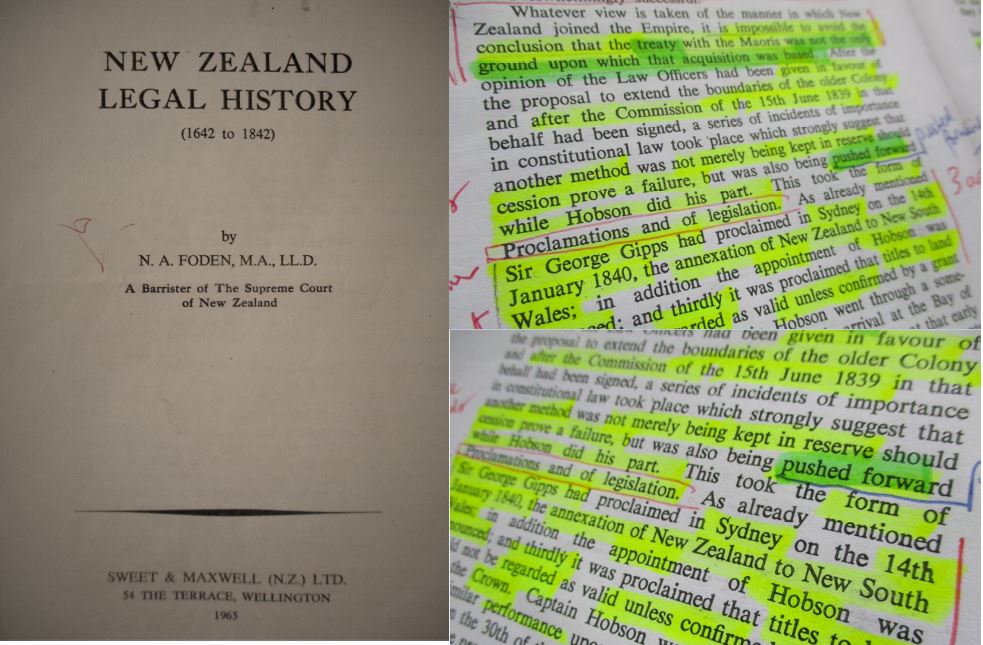
Meanwhile, the ‘Colonial Law Track’ moves, which were started and completed by the inky, feathery quill of Prince Charles’s great, great, great grandmother, Queen Victoria, perfected the incomplete title stealthily gained by Freemason Captain Bro. James Cook – as The Snoopman shows in his heretical investigation, “Royal Landlord Possession Rituals”.xii To that devious end, on June 15th 1839, Queen Victoria exercised her Royal Prerogative Powers to sign a decree known as the Letters Patent of Boundary Extension that enlarged the boundary of New South Wales, which had the effect of enveloping all of the islands of New Zealand within the jurisdiction overseen by Governor George Gipps. This parallel Colonial Law Track to the Treaty Theatre Track was essentially completed on 16th November 1840, when Queen Victoria signed the Royal Charter for Severance (or Charter of 1840), establishing New Zealand as a separate colony.
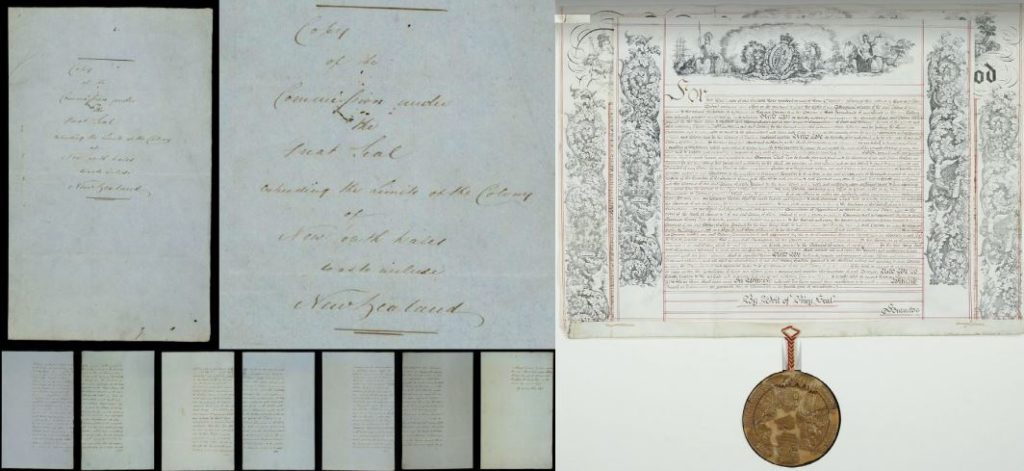
Government historian Richard S. Hill stated in his history of policing in New Zealand, that ‘cession by treaty’ was a pretence to neutralize anticipated Māori opposition, stonewall representative civil government for settlers, and to deconstruct the façade of an ‘independent state’, designed by the British. Hill found New Zealand joined the British Empire on the basis of settlement by the continuous occupation of 2000 Britons, when it was annexed by the Letters Patent of Boundary Extension on June 15th 1839 – while researching Policing the Colonial Frontier: The Theory and Practice of Coercive Social and Racial Control in New Zealand, 1767-1867, which was published in 1986 for the Department of Internal Affairs. Settlement, once formalized by a European Power, became an unchallengeable title. This finding concurs with Norman Arthur Foden’s thesis in his 1938 work, The Constitutional Development of New Zealand in the First Decade (1839-1849). Foden also found at the time of the British takeover of New Zealand, there were three classes of colonies designated according to their mode of origin: by settlement (or occupation), by conquest and by cession. However, cession of territory by indigenous peoples to a European power was considered invalid in colonial and international law because they were considered coercive. Despite producing another ground-breaking book, New Zealand Legal History (1642-1842) published in 1965, in which Foden again explored the parallel track ‘pushed forward’ to claim full paper sovereignty over New Zealand, the former barrister and solicitor of the Supreme Court was unaware of the language differences in the 1840 Waitangi Treaty.xiii
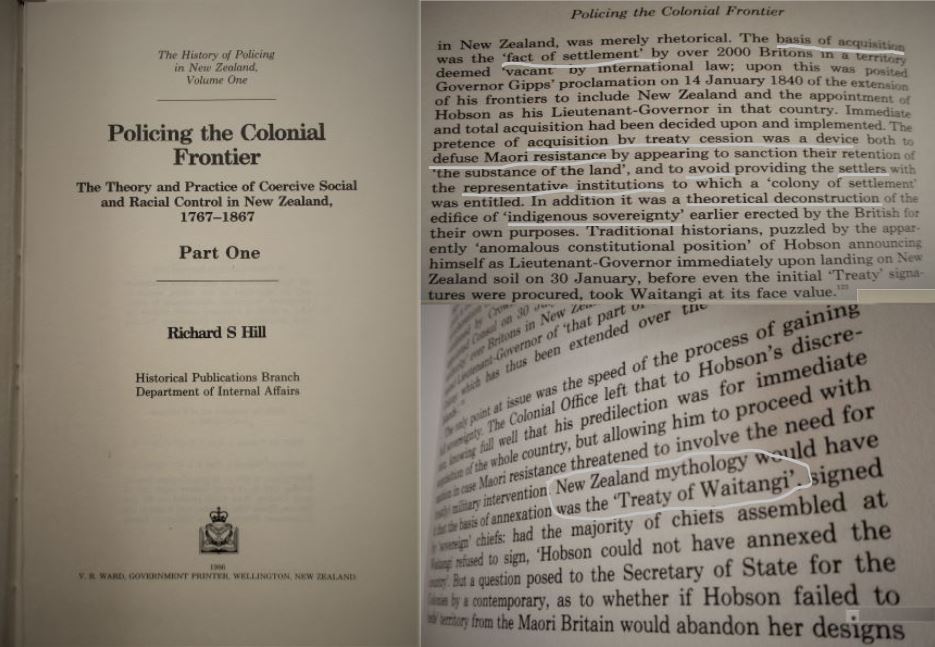
The innovation of the two language versions of the 1840 Waitangi Treaty meant that, in essence, the parchments were spun on a fulcrum that pivoted upon deceptively-crafted translation differences in the texts. By this swindle, a territory the size the Great Britain was gained on the cheap with presents, persuasion and unseemly post-haste. Had the Treaty Cliqué fully disclosed to Māori that they sought to drastically diminish their mana, accumulate their hapū political structures into tribal units for later de-tribalization and transfer their tino rangatiratanga to Queen Victoria, that Treaty Cliqué would likely have lost their heads. Therefore, the fulcrum of deceptive translation differences in the 1840 Waitangi Treaty texts worked to hide the omissions of intent, imperial context, and history.

Today, the New Zealand Crown denies New Zealanders, including indigenous Māori, the right to full disclosure, not only about the stealthy application of the Discovery Doctrine by the British 250 years ago,xiv when Captain Bro. Cook recorded he claimed possession in two places on his Endeavour Voyage. But also, the New Zealand Crown continues to pursue an unlawful, unsound and unwise course with reckless contrived ignorance about the British Crown-created ‘Myth of Cession’. This fiction that the Treaty Chiefs ceded sovereignty to the British Crown in 1840 continues because the Crown wishes to sustain its outsized sole sovereign power over Māori. If the Crown were to very publicly admit that cession by treaty is a myth, and explain – with full disclosure – the how, the who and the why exactly, that the Treaty Theatre worked in tandem with a parallel Colonial Law Track, then it would face significantly diminished power. Given the Crown’s continued course of reckless contrived ignorance about the ‘Myth of Cession’, it is no small wonder that the Ardern Coalition Government invited Prince Charles to visit in mid-November 2019.xv
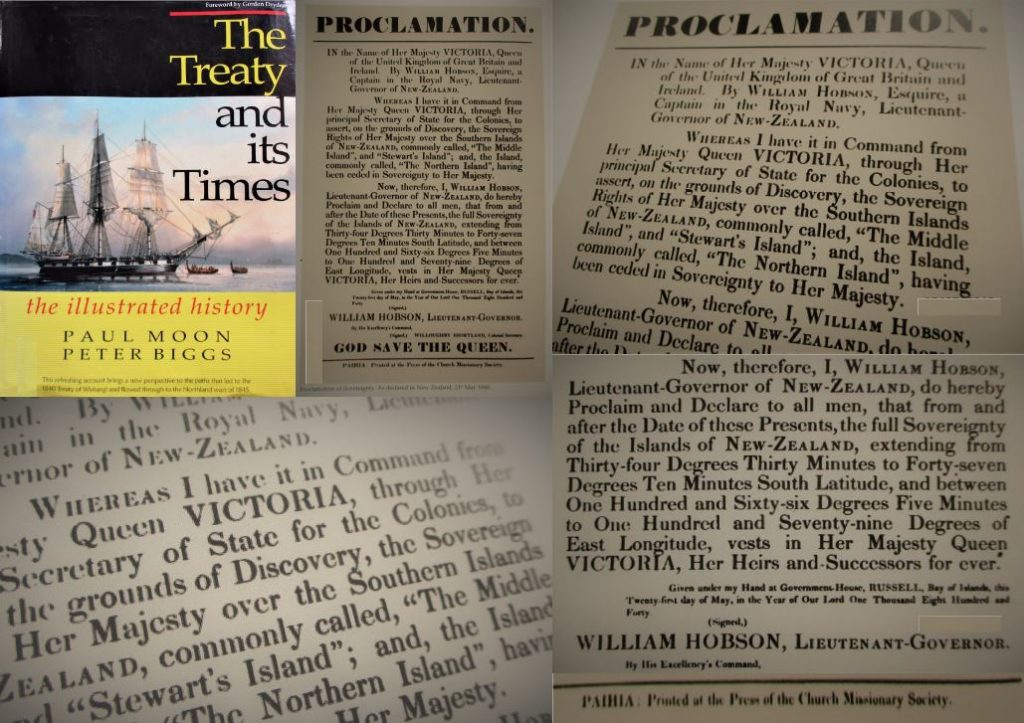
The Royal visit to New Zealand by the neo-feudal billionaire, The Prince of Wales, and his wife, The Duchess of Cornwall, was a charm offensive, crisis intervention, and legal exercise to maintain the hereditary rights of the British Monarchy over the Realm — that was wrested by swindle, stealth and struggle. It was as much about pulling the Waitangi host iwi, Ngāpuhi, into the Crown’s orbit to settle, cede, and submit — as it was about ensuring that land buy-backs for Māori, such as at Ihumātao, don’t become an election issue in 2020.xvi The control of both of these narratives is critical for the Neo-Feudal Crown, because its political kryptonite weakness is close exposure to the ‘Myth of Cession’ by treaty.xvii
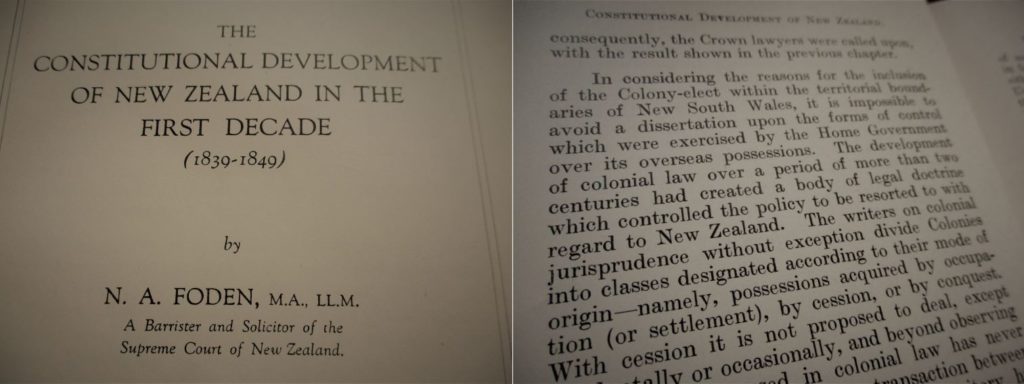
Because, if matters were to snowball into a widespread shift in the political ground around the Crown, whereby a sustained groundswell supporting private land being vested to hapū and iwi with Māori sovereign title — then the Crown could quickly undergo an exquisite catastrophic collapse in its power. It appears the Crown has sought to control the crisis rituals to avoid noisy-amplified discussion about how exactly and why exactly private land buybacks became a scared cow issue.xviii
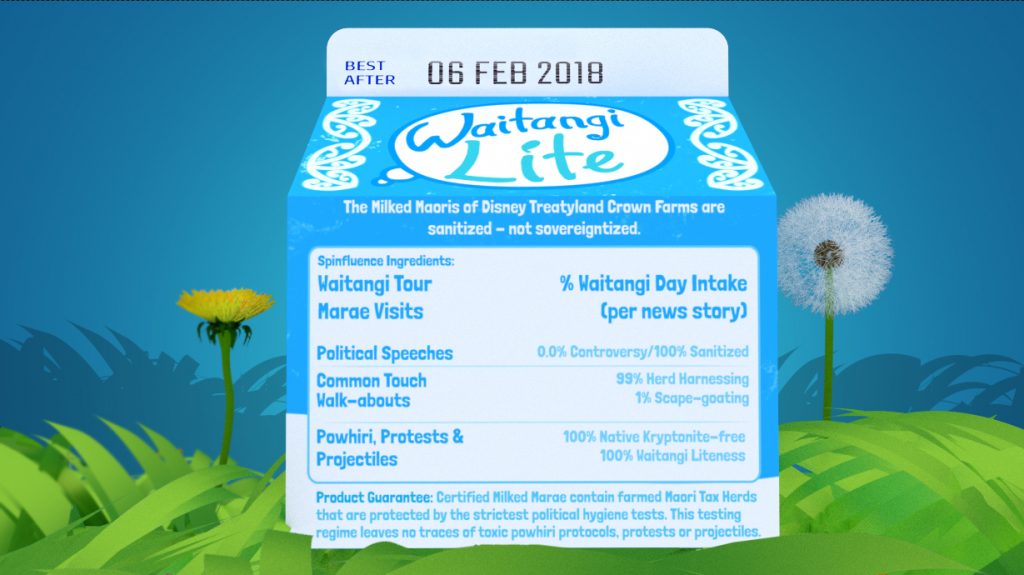
It turns out, land buybacks for Māori were short-circuited by a malicious act of arson on July 4th 1992, that was self-inflicted by a farmer Alan Titford. Because Titford blamed a Northland iwi, Te Roroa – whom sought the return of urupa, burial caves and other wāhi tapu sites on farmed lands at the Maunganui Bluff, Aranga, north-west of Dargaville – and because National MP Ross Meurant rang The New Zealand Herald, New Zealand’s cultural-wide racism held sway to green-light more institutionally racist, structural stonewalling – as The Snoopman showed in “Fraught Precedents for Land Buy-Backs”.xix The racist furore stirred up by Titford and his farming supporters resulted in the Bolger-National Government barring the Waitangi Tribunal from recommending such sacrilegious property transfers and thereby making discourse about private-land buy-backs a heretical act in the racist Neo-Feudal Realm of New Zealand.

To sum up, New Zealand’s Neo-Feudal Crown recklessly contrives ignorance about the ‘Myth of Cession’ so that it can maintain its outsized power over Māori, sustain the hereditary sovereign claims of the British Monarch, and prevent a critical majority of New Zealanders comprehending the unfairness of the landed-British Monarchy maintaining the landless-ness of Māori. Gallingly, Prince Charles’s private estate, The Duchy of Cornwall, is 212 square miles spread across 23 counties of England and Wales.xx Typically, The Prince emotionally hijacked his audience with ‘hope porn’ at Waitangi, saying that N.Z. can be a world model for fixing historical injustices.xxi Perhaps, the country will insist that the Heir Apparent to the British Throne actually sells his Duchy, to pay for land-buybacks to make tangata whenua more than a phrase?xxii
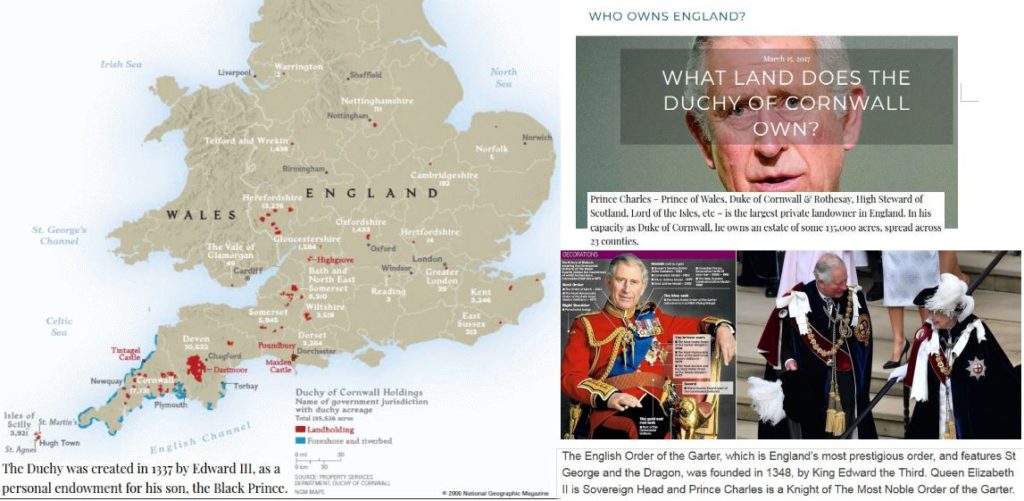
The appropriate place and time for the Crown to fess-up about the ‘Myth of Cession’ is at Waitangi 2020. If the Crown assembles a legal team dumb enough to construe my move to get the Crown to do its job fraud-free and properly – as blackmail within the meaning of section 237 of the Crimes Act – the Crown will lose.
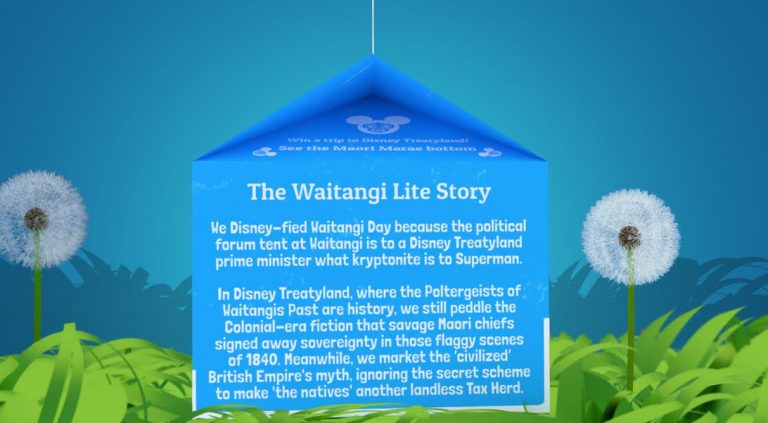
It seems apt to call out this perniciously persistent ‘Myth of Cession’ with a quote David Luban drew from a U.S. trial to signpost the workings of contrived ignorance — “Ostriches … are not merely careless birds.”
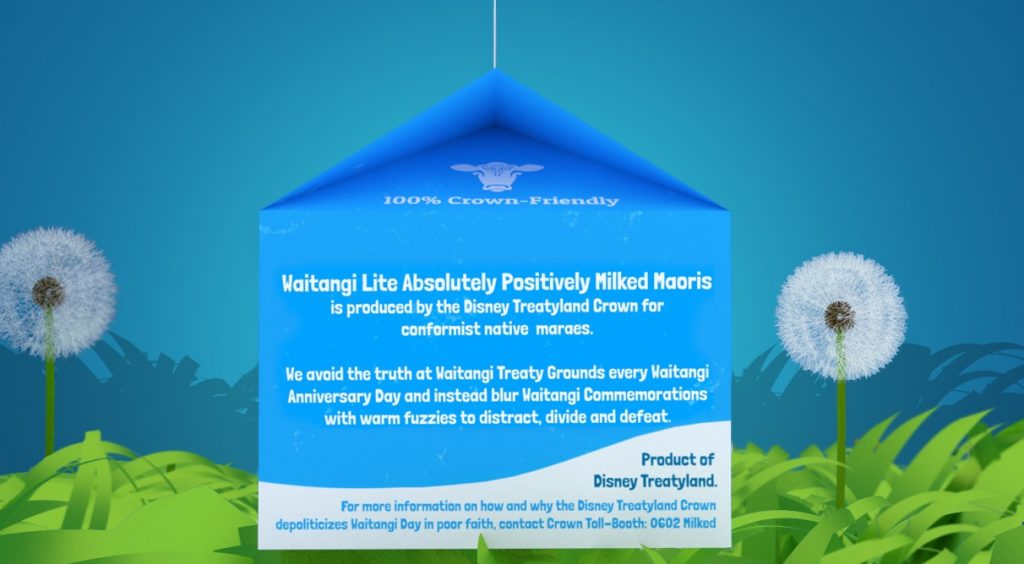
Slay,
Steve Edwards.
Editor’s Note: If there are any errors of fact, or you have any further information, please contact our intern, Steve Edwards. e: steveedwards555@gmail.com
* This letter was emailed Friday evening December 6th 2019 to numerous ministers in the Ardern Administration: Andrew Little, Nanaia Mahuta, Jacinda Ardern, Winston Peters, Kelvin Davis, David Parker, Willie Jackson, Peeni Henare, David Clark, Aupito Sio, Shane Jones, Fletcher Tabuteau, Carmel Sepuloni, Tracey Martin, Poto Williams and Jan Logie — as well several media outlets and some academics.
[insert epiphanies here] #WaitangiDisneyTreatyland — [Snoopman News]
Referenced Sources:
i The Snoopman. (3 December 2019). Royal Landlord Possession Rituals. Snoopman News. Retrieved from https://snoopman.net.nz/2019/12/03/royal-landlord-possession-rituals/
ii PMC Editor and Steve Edwards. (February 6, 2018). Crown breached Crimes Act over ‘depoliticising’ Treaty of Waitangi. https://asiapacificreport.nz/2018/02/06/crown-breached-crimes-act-over-depoliticising-treaty-of-waitangi/
iii Waitangi Tribunal. (October 2014). He Whakaputanga me te Tiriti: the Declaration and the Treaty. The Report on Stage 1 of the Te Pararahi o Te Raki Inquiry. Wai 1040. Retrieved from: www.waitangitribunal.govt.nz
iv Crimes Act 1961. Section 240. Crimes involving deceit 240. Obtaining by deception or causing loss by deception. Parliamentary Counsel Office. New Zealand Neo-Colonial Government. Retrieved from: http://www.legislation.govt.nz/act/public/1961/0043/latest/DLM330275.html
v Steve ‘Snoopman’ Edwards. (September 18, 2018). Harnessing the Herd to Hide a Historical Heist: How and why the Crown’s marketing of the myth that Māori signed away sovereignty in 1840 breaches the Crimes Act of 1961. https://snoopman.net.nz/2018/09/18/harnessing-the-herd-to-hide-a-historical-heist/
vi Steve ‘Snoopman’ Edwards.(February 6, 2018). Waitangi Investigation: Steve Edwards – Harnessing the Herd to Hide a Historical Heist: The Crown’s breach of the Crimes Act. The Daily Blog https://thedailyblog.co.nz/2018/02/06/waitangi-investigation-steve-edwards-harnessing-the-herd-to-hide-a-historical-heist-the-crowns-breach-of-section-the-crimes-act/
vii David Luban. (2007). Legal Ethics and Human Dignity. Cambridge Studies in Philosophy and Law. https://static1.squarespace.com/static/58d6b5ff86e6c087a92f8f89/t/593dfef59de4bbf286f362c8/1497235211718/David+Luban+Legal+Ethics+and+Human+Dignity+Cambridge+Studies+in+Philosophy+and+Law++2007.pdf
viii David Luban. (1999). “Contrived ignorance”. The Georgetown Law Journal. https://scholarship.law.georgetown.edu/cgi/viewcontent.cgi?article=2765&context=facpub
ix Emily Blincoe. (2015). “The Myth of Cession: Public Law Textbooks and The Treaty of Waitangi”, p. 8-9. Faculty of Law, Victoria University. Retrieved from: http://researcharchive.vuw.ac.nz/xmlui/bitstream/handle/10063/5021/paper.pdf?sequence
x Worried Māori chiefs voiced their concerns. Ngāi Tawake rangatira Rewa spoke prophetic insights when he said, “What do Native men want of a Governor? … Send the man away; do not sign the paper; if you do you will be reduced to the condition of slaves, and be obliged to break stones for the roads. Your land will be taken from you, and your dignity as chiefs will be destroyed.” Excerpt of kōrero. Waitangi Treaty hui of February 5 & 6, 1840. As cited In: Waitangi Tribunal. (October 2014). He Whakaputanga me te Tiriti: the Declaration and the Treaty, p. 358.
xi The Snoopman. (3 December 2019). Royal Landlord Possession Rituals. Snoopman News. Retrieved from https://snoopman.net.nz/2019/12/03/royal-landlord-possession-rituals/
xii Royal Landlord Possession Rituals. https://snoopman.net.nz/2019/12/03/royal-landlord-possession-rituals/
xiii N. A. Foden. (1938). Constitutional Development of New Zealand in the First Decade (1839-1849). Wellington, New Zealand: L. T. Watkins Ltd; N. A. Foden. (1965). New Zealand Legal History (1642-1842); Richard S. Hill. (1986). Policing the Colonial Frontier: The Theory and Practice of Coercive Social and Racial Control in New Zealand 1767-1867 – Part One, p. 88-90. Wellington, New Zealand: Historical Publications Branch Department of Internal Affairs.
xiv The Doctrine of Discovery is a secret piece of International Colonial Law that emerged during the Crusades between 1096 and 1271, when the Vatican Empire asserted a worldwide papal jurisdiction to justify Holy Wars against Muslim Saracens, whom were cast as ‘Infidels’ . The Discovery Doctrine was further developed between European nations in the 15th Century, when they were forging maritime empires, and was designed to mitigate the chances of competing nations making expensive war with each other at the cost of much ‘blood and treasure’. A European Power gained property and sovereign rights over ‘undiscovered’ lands and indigenous peoples upon First Discovery, although the titles were considered incomplete even if the European nation took possession on paper, following the performance of discovery rituals such as raising flags and claiming the territory for a royal or papal monarch. To transform the incomplete annexed title gained on First Discovery into a European Title, the European country had to occupy and possess their newly found lands within a reasonable period. This often occurred by fort building and establishing settlements – as Robert Miller and Jacinta Ruru explained in their 2009 paper, “An Indigenous Lens into Comparative Law: The Doctrine of Discovery in the United States and New Zealand”, published in the West Virginia Law Review. Professor Robert Miller identified ten elements of the Discovery Doctrine: (1) First Discovery; (2) Actual Occupancy and Current Possession; (3) Preemption/European Title; (4) Indian Title; (5) Tribal Limited Sovereign and Commercial Rights; (6) Contiguity; (7) Terra nullius; (8) Christianity (9) Civilization; and (10) Conquest. See: Miller, Robert J. & Ruru, Jacinta. (2009). An Indigenous Lens into Comparative Law: The Doctrine of Discovery in the United States and New Zealand, Vol. 111, 849-918. West Virginia Law Review; Robert J. Miller. (2012). “The International Law of Colonialism: A Comaprative Analysis”, p. 855-856. The Future of International Law in Indigenous Affairs: The Doctrine of Discovery, the United Nations, and the Organization of American States SYMPOSIUM. Lewis & Clark Law Review.
xv Snoopman. (December 4, 2019). Wrapped Up & Under Wraps: Korowai on Loan from QEII | Crown Loan for Ihumātao Land before Waitangi Day 2020? https://snoopman.net.nz/2019/12/04/wrapped-up-under-wraps-korowai-on-loan-from-qeii-crown-loan-for-ihumatao-land-before-waitangi-day-2020/
xvi Snoopman. (December 4, 2019). Wrapped Up & Under Wraps: Korowai on Loan from QEII | Crown Loan for Ihumātao Land before Waitangi Day 2020? https://snoopman.net.nz/2019/12/04/wrapped-up-under-wraps-korowai-on-loan-from-qeii-crown-loan-for-ihumatao-land-before-waitangi-day-2020/
xvii The Snoopman. (3 December 2019). Royal Landlord Possession Rituals. Snoopman News. Retrieved from https://snoopman.net.nz/2019/12/03/royal-landlord-possession-rituals/
xviii Moana Maniapoto | Aug 25, 2019. How can there be justice if the process isn’t just? https://e-tangata.co.nz/history/how-can-there-be-justice-if-the-process-isnt-just/
xixThe Snoopman. (24 September 2019). Ihumātao | Fraught Precedents for Land Buy-Backs. Snoopman News. https://snoopman.net.nz/2019/09/24/ihumatao-fraught-precedents-for-land-buy-backs/
xx Who Owns England? (March 15, 2017). What land does the Duchy of Cornwall own? https://whoownsengland.org/2017/03/15/what-land-does-the-duchy-of-cornwall-own/; Daniel Aston. (5 August 2017). The land and property Prince Charles owns in Cornwall revealed. https://www.cornwalllive.com/news/cornwall-news/land-property-prince-charles-owns-287981
xxi NZHerald. (20 Nov, 2019). Focus Live Earlier: NZ ‘offers an example to the world’ – Prince Charles at Waitangi https://www.nzherald.co.nz/national-video/news/video.cfm?c_id=1503075&gal_cid=1503075&gallery_id=214273
xxii The Snoopman. (3 December 2019). Royal Landlord Possession Rituals. Snoopman News. Retrieved from https://snoopman.net.nz/2019/12/03/royal-landlord-possession-rituals/
